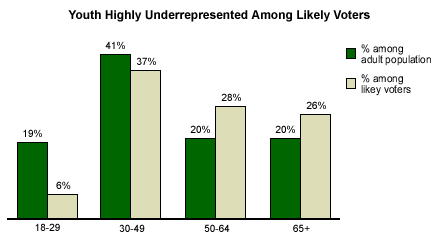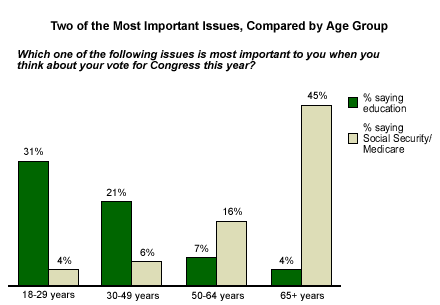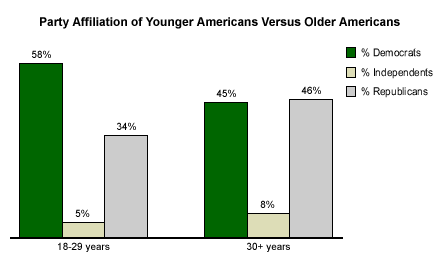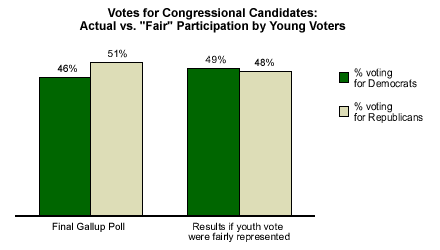It is a fact of political life that Americans under 30 are far less likely to vote than older Americans. What is perhaps not so well understood is that the low participatory rate of the young has far-reaching consequences for them and for the overall political process.
According to the latest CNN/USA Today/Gallup poll*, the last pre-election poll before today's congressional elections, Americans under 30 represent about one-fifth of the adult population (19%) that is eligible to vote**. Given their relatively low level of turnout, however, they constitute only about 6% of the actual electorate.

This disparity means that the youth voice in the elections is only one-third as strong as it should be, if young people are to be fairly represented in selecting their political leaders. The underrepresentation of the next oldest age group is minor by comparison with the youngest group: people aged 30 to 49 constitute about 41% of the adult population, but 37% of the likely electorate. Overrepresentation of the older generations is substantial. The two older age groups (50 to 64 and 65 and older) each constitute 20% of the adult population, but 28% and 26% of the electorate, respectively.
The low turnout among the young invariably means that candidates for political office are more likely to emphasize issues that affect the older generations than those of most concern to the youngest generation. In the last several weeks of the campaign, prescription drugs for the elderly and the protection of Social Security and Medicare appeared to dominate many of the campaigns. The CNN/USA Today/Gallup poll shows that those issues are of much greater concern to older than younger people. On the other hand, education seemed to be of lesser importance in the campaigns, though the poll shows it is a more salient issue for the young.

The older voters are, the less importance they attach to the issue of education, from 31% among those in the youngest group to 4% for those in the oldest group. Social Security/Medicare, however, is the most important issue for 45% of the oldest age group, but for only 4% of the youngest group.
Thus, though one issue may not be objectively more important than another to the overall population, young people may understandably have a different agenda from that of older people. When young people don't vote, they may foster a tendency among candidates to neglect issues such as education in order to focus on issues that will generate support from those more likely to vote.
Congressional Election Outcome Would Change If Young Participated
The poll also shows that younger Americans currently tend to identify more with the Democratic Party than older Americans do (though this hasn't always been the case historically). The current poll shows that among people under 30, 58% identify as Democrats, 34% as Republicans and 5% as independents. Among all other Americans, preferences for the two major parties are about evenly divided, with 45% saying they are Democrats, 46% Republicans and 8% independents.

The low turnout among young Americans, however, means that their political preferences are not proportionately represented in the electorate as a whole. Gallup's final estimate of the congressional vote is that 51% of likely voters will choose the Republican candidates and 46% the Democratic candidates. This division of the national vote is quite likely to mean that Republicans will retain majority control of the House of Representatives.
If young people were to vote at about the same rate as older people, however, the youth vote would constitute 19% of the electorate (the same percentage as young people in the adult population) and the election outcome would be very different. If the additional young people voted in roughly the same proportion as those who are already going to vote, Gallup estimates that the final projected vote would be 49% for the Democrats and 48% for the Republicans.

That shift of six percentage points -- (from a Republican lead of five points to a one-point lead for the Democrats) could mean a shift in about 25 to 30 congressional seats -- more than enough to change the balance of power from one party to the other.
In light of the consequences, it becomes very tough to argue lack of political participation among young people doesn't matter.
*Results are based on telephone interviews with 1,221 national adults, aged 18 and older, conducted Oct. 31-Nov. 3, 2002. For results based on the total sample of national adults, one can say with 95% confidence that the maximum margin of sampling error is ±3%.
**Results based on a subsample of 715 survey respondents deemed most likely to vote in the November 2002 midterm election, according to a series of questions measuring current voting intentions and past voting behavior. For results based on the total sample of likely voters, one can say with 95% confidence that the margin of sampling error is ±4%. In addition to sampling error, question wording and practical difficulties in conducting surveys can introduce error or bias into the findings of public opinion polls.